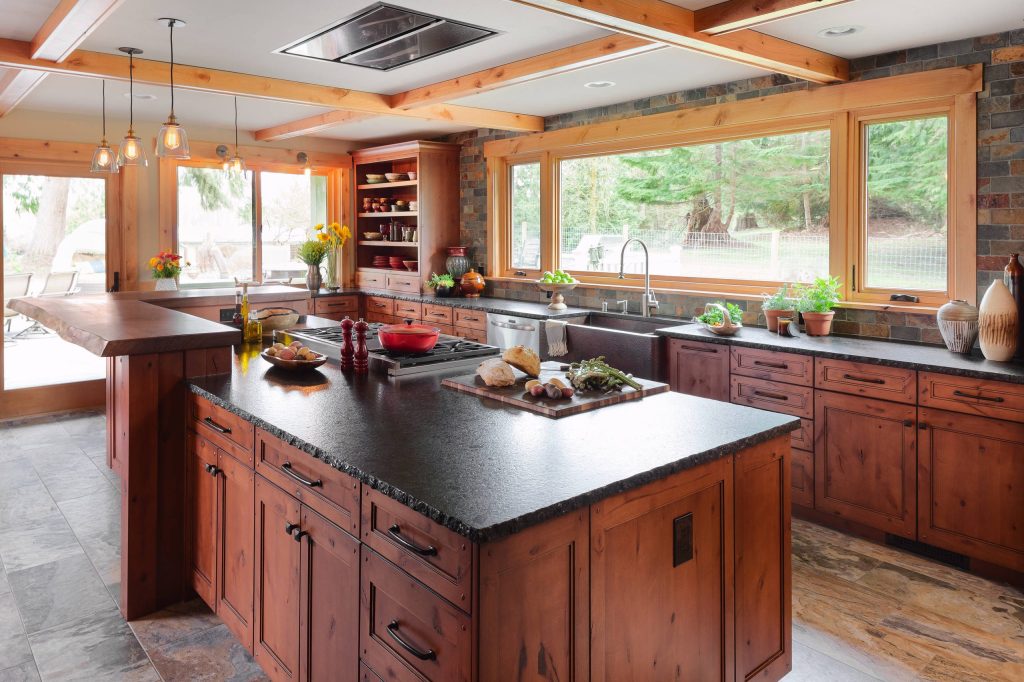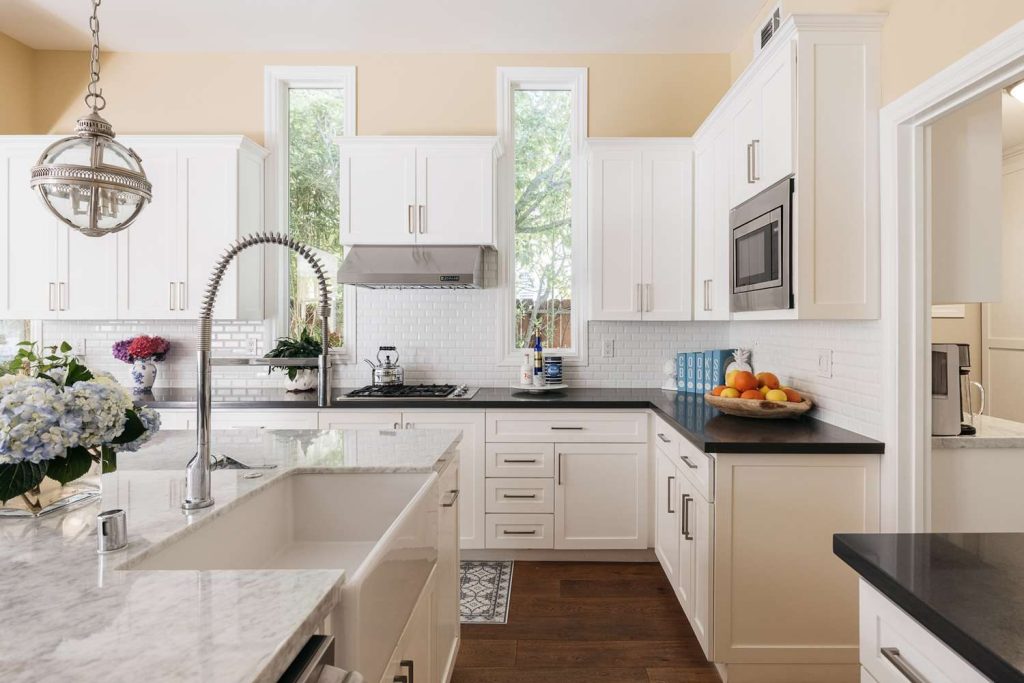The kitchen, often dubbed the heart of the home, transcends its utilitarian purpose to become a sanctuary where warmth and functionality converge.
In today’s fast-paced world, creating an inviting kitchen atmosphere has become increasingly paramount for homeowners seeking to foster a space that nurtures both culinary creativity and familial bonds.
The quintessential warm kitchen seamlessly blends aesthetics with practicality, incorporating elements that stimulate both visual and tactile senses.
As we delve into these 15 transformative ideas, we’ll explore how various design elements, from chromatic selections to textural components, can metamorphose your kitchen into a welcoming haven.
Warm Kitchen Ideas
Whether you’re planning a complete renovation or seeking subtle modifications to enhance your existing space, these carefully curated suggestions will guide you toward creating a kitchen that radiates warmth and comfort while maintaining its efficiency as a working space.
1. Rich Wood Elements

Incorporating rich wood elements through cabinetry serves as a foundational step in creating a warm kitchen atmosphere. Oak, cherry, or walnut cabinets bring an inherent warmth that synthetic materials simply cannot match. The natural grain patterns and deep tones create visual interest while providing a timeless appeal that transcends passing trends.
Beyond traditional cabinetry, consider incorporating wood through open shelving, ceiling beams, or a statement island. These elements can be mixed with modern materials to create a balanced, contemporary look that maintains the cozy feel of natural wood. The versatility of wood allows it to complement various design styles while adding depth and character to your kitchen space.
2. Warm Color Palettes

The power of color in creating a warm atmosphere cannot be understated. Earthy tones like terracotta, rust, warm beige, and soft browns can transform a sterile kitchen into an inviting space. These colors can be incorporated through wall paint, backsplashes, or decorative accessories, allowing for flexibility in both permanent and temporary design choices.
Consider layering different shades within the same color family to create depth and visual interest. Combining warm neutrals with pops of rich, saturated colors can create a dynamic space that feels both sophisticated and welcoming. The key is to maintain balance and avoid overwhelming the space with too many competing hues.
3. Ambient Lighting Solutions

Thoughtful lighting design plays a crucial role in creating a warm and inviting kitchen atmosphere. Layer different types of lighting, including pendant lights, under-cabinet illumination, and strategic task lighting to create a versatile and welcoming environment. Warm-toned LED bulbs can significantly impact the overall feel of your space.
The right lighting scheme should be both functional and atmospheric. Consider installing dimmer switches to adjust the lighting based on different times of day and activities. This flexibility allows you to transition from bright, task-oriented lighting during food preparation to softer, more intimate lighting for dining and entertaining.
4. Textured Backsplash

A textured backsplash adds depth and visual interest while contributing to the overall warmth of your kitchen. Natural stone, handmade tiles, or textured ceramic options create an engaging focal point that catches both light and attention. These materials not only protect your walls but also serve as artistic elements that enhance the room’s character.
When selecting a textured backsplash, consider how it will interact with your lighting and other design elements. The interplay of light and shadow on a textured surface can create dynamic visual effects throughout the day. Choose materials and patterns that complement your overall design scheme while adding that crucial element of tactile appeal.
5. Cozy Seating Areas

Creating a designated seating area transforms your kitchen into a more welcoming space where family and friends can gather. Whether it’s a built-in breakfast nook, comfortable bar stools, or a small dining area, incorporating soft seating elements adds an immediate sense of warmth and comfort to the space.
Consider upholstering seating in warm, inviting fabrics that are both durable and comfortable. Adding throw pillows or cushions in coordinating colors can further enhance the cozy atmosphere while providing practical comfort for extended kitchen conversations and casual dining experiences.
Related Guide: 17 Dream Kitchen Ideas
6. Natural Stone Elements

Incorporating natural stone elements, whether through countertops, island surfaces, or decorative accents, brings an organic warmth to your kitchen. Materials like granite, marble, or quartzite add texture and visual interest while providing durable surfaces for food preparation and dining.
The unique patterns and variations in natural stone create conversation pieces while grounding the space in earthy elements. Choose warm-toned stones that complement your overall color scheme and pair them with other natural materials to create a cohesive, inviting atmosphere.
7. Copper Accents

Copper elements add a rich, warm metallic glow to your kitchen space. From hanging pots and pans to light fixtures and hardware, copper accents create points of visual interest while developing a beautiful patina over time. This living finish adds character and depth to your kitchen’s design.
Consider mixing copper with other metallic finishes for a more eclectic, collected-over-time feel. The warm undertones of copper complement both traditional and modern design styles, making it a versatile choice for adding warmth to your kitchen.
8. Vintage Elements

Incorporating vintage pieces adds character and a sense of history to your kitchen. Whether it’s a restored farmhouse sink, antique light fixtures, or repurposed furniture pieces, vintage elements bring unique charm and warmth to the space. These pieces tell stories and create conversation starters while adding visual interest.
Mix vintage elements with modern conveniences to create a kitchen that feels both nostalgic and functional. The key is to select pieces that complement your overall design while adding that crucial element of personality and lived-in charm.
9. Open Shelving Display

Open shelving provides opportunities to display cherished items while adding visual warmth through carefully curated collections. Whether showcasing family heirloom dishes, cookbooks, or artisanal pottery, open shelves create an inviting atmosphere that feels personal and lived-in.
Style your open shelving with a mix of functional and decorative items, keeping organization in mind. The key is to create balanced displays that add character without cluttering the space. Consider incorporating plants or herbs to add life and color to your shelving arrangement.
10. Woven Textures

Introducing woven elements through baskets, window treatments, or seating adds natural texture and warmth to your kitchen. These elements soften the hard surfaces typically found in kitchens while providing practical storage solutions and visual interest.
Layer different woven materials and textures to create depth and dimension in your space. From natural fiber rugs to woven pendant lights, these elements add a cozy, organic feel to your kitchen while maintaining functionality.
11. Layered Window Treatments

Thoughtful window treatments not only provide privacy and light control but also add softness and warmth to your kitchen. Layer sheer curtains with more substantial drapes in warm tones to create a cozy atmosphere while maintaining flexibility in natural light control.
Choose fabrics that complement your color scheme and add texture to the space. Consider treatments that allow for easy adjustment throughout the day to maximize natural light while maintaining the warm, inviting atmosphere you’ve created.
Related Guide: 14 Stunning Open Kitchen Ideas
12. Warm Metal Hardware

Selecting hardware in warm metallic finishes like brass, bronze, or copper adds subtle warmth throughout your kitchen. These small details can have a significant impact on the overall feel of the space while providing necessary functionality.
Mix different warm metal finishes for an eclectic, collected look that adds depth and interest. Consider how these elements will patina over time and choose finishes that will age gracefully with your kitchen.
13. Rustic Elements

Incorporating rustic elements through exposed beams, distressed finishes, or reclaimed materials adds character and warmth to your kitchen. These elements bring a sense of history and authenticity while creating visual interest and depth.
Balance rustic elements with modern conveniences to create a space that feels both comfortable and functional. The key is to select pieces that add warmth without overwhelming the space or compromising its functionality.
14. Soft Textiles

Adding soft textiles through kitchen linens, cushions, and rugs creates layers of warmth and comfort in your space. Choose materials that are both beautiful and practical, considering the high-traffic nature of kitchen environments.
Layer different textures and patterns while maintaining your color scheme to create a cohesive, inviting atmosphere. Remember to select materials that are easy to clean and maintain while adding that crucial element of softness to your kitchen.
15. Organic Decor

Incorporating organic elements through plants, herbs, or natural materials adds life and warmth to your kitchen space. Living elements create a connection to nature while providing practical benefits like fresh herbs for cooking or improved air quality.
Display organic elements in creative ways that complement your overall design scheme. Consider hanging plants, herb gardens, or natural branch arrangements to add height and visual interest to your warm kitchen design.
Conclusion
Creating a warm kitchen environment is about thoughtfully layering elements that appeal to both the visual and tactile senses. By incorporating these 15 ideas, from rich wood elements to organic decor, you can transform your kitchen into a welcoming haven that balances style with comfort.
Remember that the most successful warm kitchen designs reflect personal style while maintaining functionality. As you implement these ideas, focus on creating a space that not only looks inviting but also supports your lifestyle and cooking habits. The result will be a kitchen that truly serves as the heart of your home, welcoming family and friends to gather, create, and share memorable moments together.

